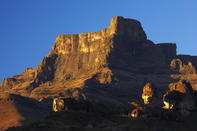Times of War

Following the ravages of the impis of Shaka other warlords, the whole Drakensberg area was decimated. This and subsequent upheavals which spread across much of Southern Africa are often referred to as the Difaqane or Mfecane wars, but some historians dispute that there was one definite period of widespread warfare.
Who knows? What we do know is that the tribes around the Drakensberg were displaced, one by the next, and that many of the surviving clans turned to cannibalism. One of these was led by a Chief Sidinane whose people occupied a cave now known as ‘Cannibal Cave’.
They would raid the lowlands and capture anyone they found alone or straggling behind a group fleeing from some or other terror. If passers-by were in short supply, they'd eat their own children and wives - this was recorded by white travellers and missionaries who passed through and actually visited the caves.
Those images of missionaries in pots that made popular cartoons in Europe came from these parts and times. This occured in the 1820s and 30s, and when the Voortrekkers reached KwaZulu-Natal they claimed they found no settlements from the mountains to the sea.
An old man once told a historian that there was a path of white from Witzieshoek to Bushman's Nek 'and that mark was our bones'. So, Difaqane or not, those were rough times. The troubles, which reduced the population of the area from an estimated one million to around 5 000, started before Shaka's Reign.
It appeared to have been in the time of Dingiswayo and Matiwane, who started the first major war. One tribe pushed against another; Mthwethwe attacked Amangwane, who fled into the Drakensberg to displace the Amahlubi, who fled into the foothills and laid waste the Amazizi, who then turned on the Bushmen.